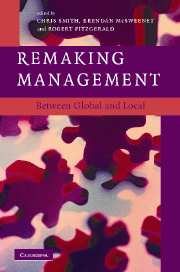Book contents
- Frontmatter
- Contents
- List of tables
- Notes on contributors
- 1 Remaking management: neither global nor national
- Part I Conceptualising International and Comparative Management
- Preface: Dominance, diversity and the historical process in management practice
- 2 Work organisation within a dynamic globalising context: a critique of national institutional analysis of the international firm and an alternative perspective
- 3 Cultural diversity within nations
- 4 Business systems, institutions and economic development: the value of comparison and history
- Part II Systems in Transition
- Part III Society as Open and Closed
- Part IV The Search for Global Standards
- Index
3 - Cultural diversity within nations
Published online by Cambridge University Press: 06 July 2010
- Frontmatter
- Contents
- List of tables
- Notes on contributors
- 1 Remaking management: neither global nor national
- Part I Conceptualising International and Comparative Management
- Preface: Dominance, diversity and the historical process in management practice
- 2 Work organisation within a dynamic globalising context: a critique of national institutional analysis of the international firm and an alternative perspective
- 3 Cultural diversity within nations
- 4 Business systems, institutions and economic development: the value of comparison and history
- Part II Systems in Transition
- Part III Society as Open and Closed
- Part IV The Search for Global Standards
- Index
Summary
The appeal to national character is generally a mere confession of ignorance.
Max Weber (1992 [1904–5]: 88)Introduction
Are workplace practices shaped by national context? Are those practices embedded, inflexible, path-dependent? Is there a national path? Is there a single ‘best fit’ between practices and specific national contexts? Norbert Elias observes that ‘[s]ocial norms are often discussed in a manner which suggests that the norms of one and the same society are all of a piece’ (1996: 158). Belief in such uniformity is the bedrock of the notion of enduring and determining national culture popular in the management literature (Oyserman, Coon and Kemmelmeier, 2002; Søndergaard, 1994). In contrast to national homogeneity claims, however, Elias argues that ‘[i]n societies above a specific level of differentiation, inherently contradictory codes of norms can co-exist in varying degrees of amalgamation and separation. Each may be activated in different situations and at different times.’
In line with Elias's view, and against the image of static mono-national cultures, the existence of dynamic cultural diversity within countries is argued for in this chapter. It does so through a rereading of the national cultural literature itself against a backdrop of contrary data. An analysis of the key categories and claims in the national culture literature and of its reliance on discarded concepts from other disciplines shows that it inappropriately represents national heterogeneity as homogeneity. It spreads, as Maurice Farber says, a ‘homogeneous semantic veneer over the cracks in the social structure of nations’ (1950: 311).
- Type
- Chapter
- Information
- Remaking ManagementBetween Global and Local, pp. 61 - 89Publisher: Cambridge University PressPrint publication year: 2008
- 3
- Cited by



